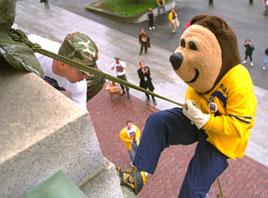|
HOME | SEARCH | ARCHIVE |
|
Last-minute madness doesn’t faze volunteers
Campus gets ready for Cal Day
![]()
By Diane Ainsworth, Public Affairs
| |  Ever dreamed of rappelling down a mountainside? How about down the face of four-story Wheeler Hall? Oski shows how it's done — and visitors try their hand, on Cal Day, from 9 a.m. to 4 p.m., Saturday, April 21. The rappelling clinic is sponsored by the campus’s Army ROTC students. Ben Ailes photo |
18 April 2001
|
How do you move four steel drums from the parking lot across from the Berkeley Art Museum and Pacific Film Archive into the museum’s sculpture garden? But that’s not the only 11th-hour worry for Lana Buffington, the Pacific Film Archive’s community liaison and one of 30 staff, graduate students and volunteers for the film archive’s Cal Day festivities. She’s still looking for an artist to show kids how to string pasta into choke necklaces and other accessories. She’s already got an artist to help them sculpt papier-maché masks. Then there are the phone calls reminding those who volunteered their services for the annual open house. “Oh…did I?” is the occasional answer to her call. “We are pretty experienced with pulling the details together at the last minute, but there’s always something that comes up,” she said light heartedly. “But right now, much to our chagrin, we’ve discovered that we don’t have a sign-language interpreter for our shows. We’re still looking for someone.” Parking, of course, is always a last-minute concern. “We’re hoping to get reserved parking at the Underhill lot, but we never know until the tail end,” Buffington said. Thousands of people show up for Berkeley’s annual Cal Day open house, to be held Saturday, April 21, from 9 a.m. to 4 p.m. This year’s event offers more than years past, with families and prospective students coming from around California to get an inside look at one of the world’s premiere universities. Free to the public, Cal Day has become a tradition that annually attracts more than 30,000 visitors. Attendees can dig for fossils at a mock archeological dig, rappel down a building or, for the energy conscious, take a tour of Berkeley’s power co-generation plant to see how the campus turns waste heat into useful electricity. A highlight this year will be a talk by Professor Daniel McFadden, winner of the 2000 Nobel prize in economics, on how economics relates to our everyday choices. Other Cal Day faculty lectures include neuroscientist Corey Goodman, who will explain how our brains are wired, and civil engineer James Rector, who will cover modern-day methods of searching for buried treasure. Prospective students of any age may drop by the new “Kindergarten to College” resource fair, organized to help students and their families prepare for college; the fair takes place from 9 a.m. to 4 p.m. in Dwinelle Plaza. Residence halls and student facilities will be open for tours between 10 a.m. and 5 p.m. Newly admitted students and their families are invited to meet Chancellor Berdahl at 8:30 a.m. at Haas Pavilion and to enjoy information sessions on academic programs, financial aid, housing and other campus services. All Cal Day visitors are invited to explore Berkeley museums for free. Meet T. Rex and tour the Museum of Paleontology from 9 a.m. to 4 p.m., or bring the kids to “Family Day — Arts 2001” from 11 a.m. to 3:30 p.m. at the Berkeley Art Museum, for music, storytelling and art-making workshops. Browse art collections that are seldom open to the public. Or see a variety of “wowie bugs,” dozens of drawers of perfectly pinned and preserved insects and large, colorful specimens in the Essig Museum of Entomology in Wellman Hall. “We have spiders and centipedes, scorpions, beetles, you name it,” quipped Cheryl Barr, who is coordinating the insect display single handedly this year. Large slide and alcohol-preserved collections, as well as many specimens in envelopes and mounts, will be on exhibit for curious kids and adults. The Essig Museum is home to one of the largest collections of arthropods in the United States, with more than 5 million species, primarily from western North America and the northern neotropics. Visitors may also tour the Jepson Herbaria, with its extraordinary collection of plants (9 a.m. to 3 p.m.), the campus radio station KALX (10 a.m. to 2 p.m.), and the special collection of manuscripts and rare video footage at the Mark Twain Project in Doe Library (10 a.m. to 3 p.m.).
For those who prefer heavenly delights to earthly wonders, a guided tour
of Berkeley’s High-Energy Solar Spectroscopic Imager satellite mission
control center will take them up to Grizzly Peak. Visit the 35-foot satellite
dish and HESSI’s ground station at the Samuel L. Silver Space Sciences
Lab between 10:30 a.m. and 1:30 p.m. to learn about a mission to be launched
in mid-May to study the sun at solar maximum. On the way back down to
Sather Gate, Dwinelle Plaza and the Wheeler Hall marketplace, stop by
the Lawrence Hall of Science for a planetarium show or a quick cuddle
with live, furry animals.
Carefully!
But don’t forget to look up when you hear the roar of the Air Force ROTC
cadets flying overhead. Between 12:30 p.m. and 1 p.m., they’ll be swooping
through the air in two aerobatic aircraft to demonstrate aerial formations
and maneuvers.
Home | Search | Archive | About | Contact | More News
Copyright 2000, The Regents of the University of California.
Produced and maintained by the Office of Public Affairs at UC Berkeley.
Comments? E-mail berkeleyan@pa.urel.berkeley.edu.